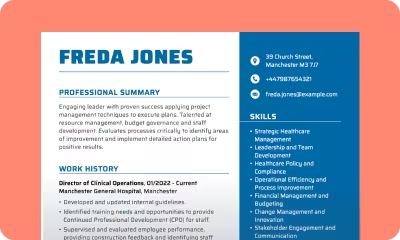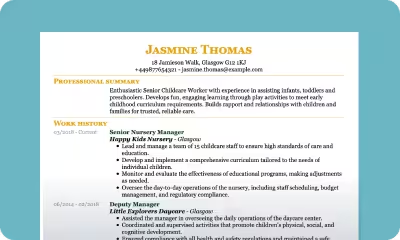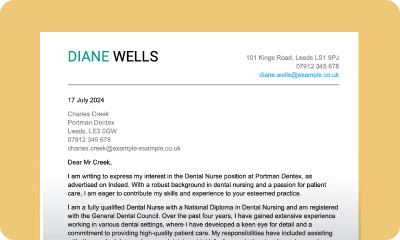How to introduce yourself professionally
Knowing how to present yourself professionally well is a key to success in the job market. Find out how you, too, can make a great first impression with your CV as the main tool in your arsenal.

Our customers have been hired by: *Foot Note
Knowing how to introduce yourself professionally, and doing it well, is an underrated skill that can make or break your chances of landing a job. We’ve all heard by now how important first impressions are, and how difficult it is to change them once they form in a matter of seconds (yes, seconds!)
That’s why crafting an effective, self-assured opening, both within your CV and in other work-related settings, is such a crucial step in your job-hunting journey.
Below, we’ll look at how you should introduce yourself in many different professional contexts, how you shouldn’t, as well as how best to introduce yourself at different stages of the recruitment process.
How to introduce yourself professionally on a CV
Given that you’re here, reading an article on a website that has the word “CV’ in its name, you probably don’t need to be reminded of the power of a well-crafted curriculum vitae. Even so, what is worth repeating is how quickly your CV is deemed worthy of attention, or the opposite, once it lands in the hands of recruiters, employers, and so forth.
The exact number of seconds falls somewhere between 6 and 8 seconds. Yes, that’s how long it takes recruiters, on average, to come to a decision regarding your strength as a candidate. If your CV fails to resonate in that time, it’s unlikely that all of your impressive qualities and even your first class degree will be able to sway the recruiter in your favour again.
However, instead of dwelling on how dire this statistic sounds, let’s look into how we can turn the tide in your favour, helping your CV land on your reader’s desk with an optimistic bang!
So, which parts of your CV make up those 6-8 seconds of recruiters’ analysis? If you guessed “professional summary” (also known as your personal statement), you’re correct! Most recruiters will have based most of their decision as to whether to hire you on that short statement alone. Which is precisely why you want to make sure you get it right.
Below, you’ll find some sample CVs - take a look at the professional summary section for some ideas on how to structure your own curriculum vitae.
Introducing yourself professionally on your CV - Tips
So, you want to write a good summary statement. You’re probably feeling quite apprehensive and unsure how to start. It seems so short and yet you have to make sure you’re presenting yourself in the best light possible, and also doing it in a way that resonates with the person whose desk it ultimately lands on. Do not despair, however – take a look at the tips we’ve prepared for you below to get you started.
Go easy on the details
The last thing you want to do is bore your potential employer from the get-go. That’s why it’s so important to strike the right balance between informative and interesting, and also concise when writing your summary statement. Stick to the most important elements, especially those relevant to the role you’re applying for.
Use the third person
While talking about yourself as if you were referring to someone else may seem a bit odd at first, trust us on this one – third person is best when writing your personal statement. Using the third person makes whatever you write sound a lot more objective, less boastful, and most importantly, it sounds far more professional than leading with “I am”.
Use the right adjectives
Another important component of a strong personal summary is all to do with the words you use to describe yourself in your CV. Adjectives are a powerful tool in your toolbox that allow you to talk about your skills and experience in a creative way, helping you impress potential employers. Make sure to use the right ones for the role you are applying for – whether leadership or customer service – to convey your suitability.
Highlight key skills and experiences
Now that you know how to write your CV summary statement, let’s look at the what, too. You’ll definitely want to mention your key skills, experiences, and accomplishments that are most relevant to the role. Pay special attention to the requirements outlined in the job description to help your summary statement immediately resonate with both applicant tracking systems (ATS) and potential employers alike.
Quantify your achievements
Where possible, make sure to include hard numbers or percentages to provide concrete evidence of your professional success. For example, you could mention how you increased sales by a certain percentage, or managed a team that achieved specific targets. Numbers will show your hiring manager that you have a track record of success and can deliver real results.
Tailor to the job
You’ve probably seen us repeat this time and time again, but that’s only because it’s so important. Customising your summary statement, and the rest of your CV, for each job application in a way that aligns with the requirements of the position you’re interested in will definitely go a long way. While you’re at it, use keywords and phrases from the job description to demonstrate your fitness for the role.
Proofread carefully
And lastly, don’t just send off your CV without giving it a second read and doing some polishing. While you may be super keen to just be done with it, you also wouldn’t want to ruin your chances of getting an interview because of a typo or an odd-sounding sentence. Iron these things out and impress your hiring manager with your attention to detail.
How to introduce yourself when emailing your CV
Now that the summary statement for your CV is done and dusted, let’s move onto another realm of professional introductions: email.
Although a lot of your applications may take place via job searching websites, email still remains a very important medium that should feature in your job-hunting process. Not only is it fast and convenient, but it also provides you with a direct communication channel between you and potential employers.
In many cases, it helps streamline the application process and helps you get noticed faster. At the same time, emailing requires you to really think through how you present yourself in the email you attach your CV to.
Again, the task may seem daunting and somewhat overwhelming, but worry not! Take a look at our list of Dos to help guide you through the process.
Do: Include a strong subject line
The subject line of your email will be the first thing the hiring manager will see when you contact them. Make sure to make yours catchy enough to grab their attention. Be sure to include relevant information such as the job title, your name, as well as some strong adjectives and keywords.
Do: Greet your respondent using their name
Nothing screams “lazy” like the overused “Dear Sir/Madam”. Be sure to refer to your addressee by their name to show you went the extra mile, and add a more personal touch from the start. Doing so is far more likely to grab their attention than the above.
Do: Start with a killer opening line
Now that your email has been opened, it’s important to hold onto your addressee’s attention with a killer CV headline. Open with an enthusiastic tone, describing who you are and reference the job you are applying for. Use the opening line to highlight one or two key (relevant) qualifications or experiences that make you a strong candidate for the position.
Do: Get to the point
The email is not a cover letter and there’s a chance that it’s being read by the hiring manager between meetings. Don’t drone on and get straight to the point. Be bold in expressing what you want and explain why you deserve to get it.
Do: Thank your reader for their time
You’ve come to the end of your email. Make sure to thank the hiring manager for their time. Ending on a note of gratitude has been shown to boost your chances of success.
How to introduce yourself when handing in your CV in person
Although the Internet has largely taken over the world of job applications, the traditional route of submitting your CV in person hasn’t totally died out. It still offers a great way to get your foot in the door if you’re a student with no experience looking for a summer job, or if the company you’re applying for is based locally.
Feel free to go down this route if the roles you are interested in include babysitting, cleaning, pet-sitting, as well as many hospitality jobs. We advise against handing in your curriculum vitae in person to large multinational companies. Those tend to prefer all applications to go through the web, and it’s likely your paper CV would end up getting lost in the shuffle.
Okay, so, now that you’ve decided handing in your CV personally is in fact the way to go, we need to again consider our key question: how do you introduce yourself professionally when handing in your CV?

STEP 1
Take care of your appearance
Like it or not, the very first impression you make will be based on how you look. Look scruffy and disorganised, and you’re likely to put off your potential employer permanently despite all of the great qualities that make you employable. Make sure to really prepare for the encounter; wear a clean, ironed shirt or top and brush your hair.
STEP 2
Introduce yourself with confidence
Now that you have the attention of your potential employer, the floor is yours and it’s time to really give it your best. Introduce yourself, say why you’ve come in, and briefly state why you believe you could make a great contribution. Avoid awkward six-word introductions, but also be mindful of saying too much and losing your reader. Balance is key here.
STEP 3
Present your CV
Once you’ve told your potential employer why you’d be a great fit for the role, offer your CV to back it up. Of course, it goes without saying that by this point, your CV should be formatted correctly, contain a strong summary statement, and not feature any major creases.
STEP 4
Thank them for your time and leave
Last but not least is leaving gracefully. Make sure to offer your gratitude for the time they’ve offered you, express your openness to answer additional questions, and finally say your goodbyes with a big smile.

Izabela Grochowska
Content Writer
Izabela Grochowska is a lifelong lover of the written word, and a passionate copywriter with a wealth of experience crafting content across a myriad of topics. From captivating blog posts to engaging website copy, her knack for writing knows no bounds.
*The names and logos of the companies referred to above are all trademarks of their respective holders. Unless specifically stated otherwise, such references are not intended to imply any affiliation or association with myperfectCV.










